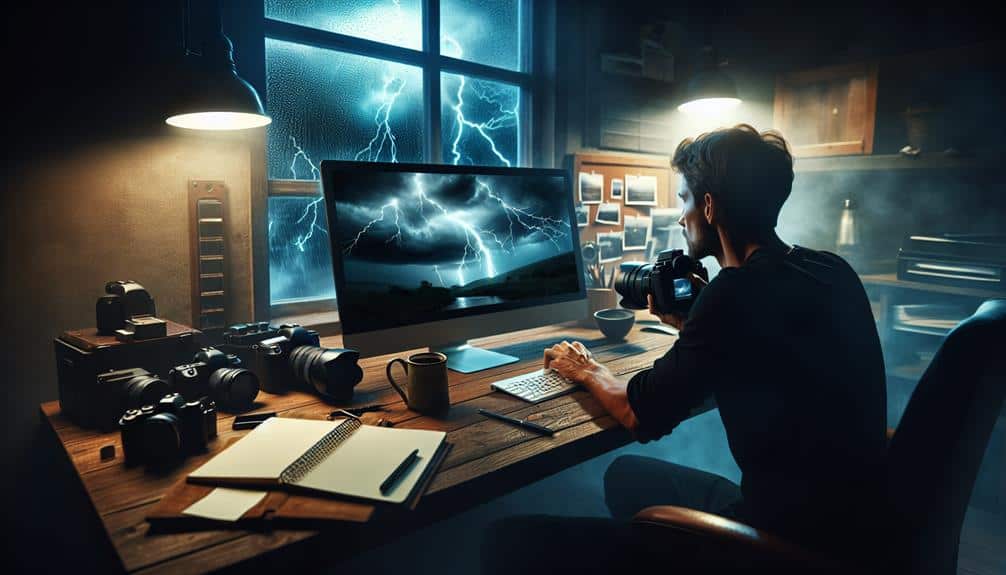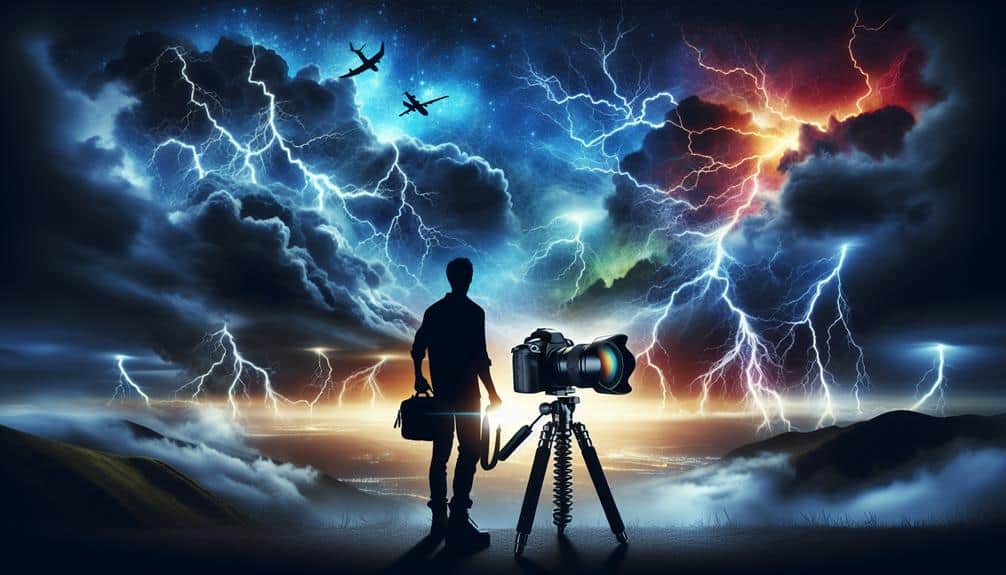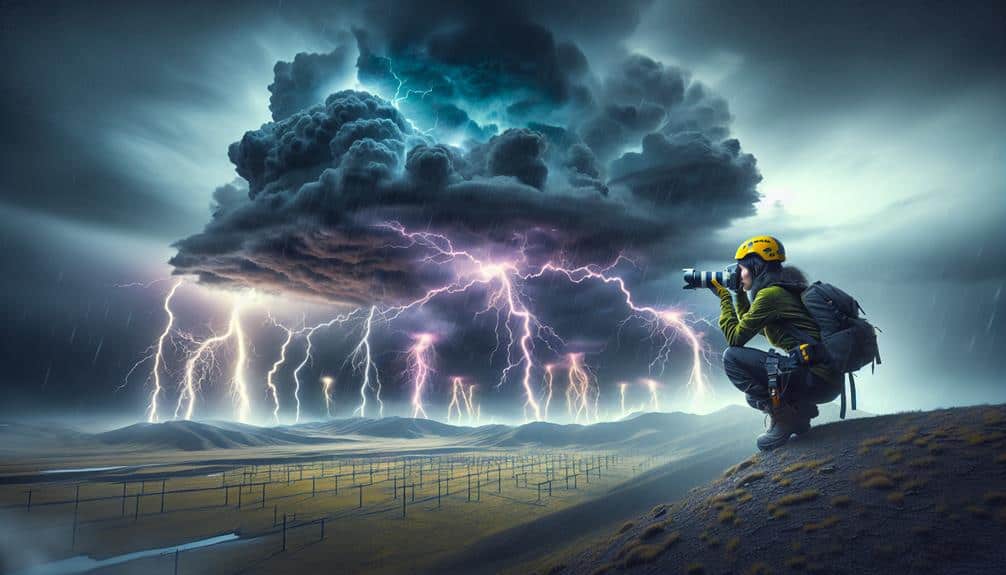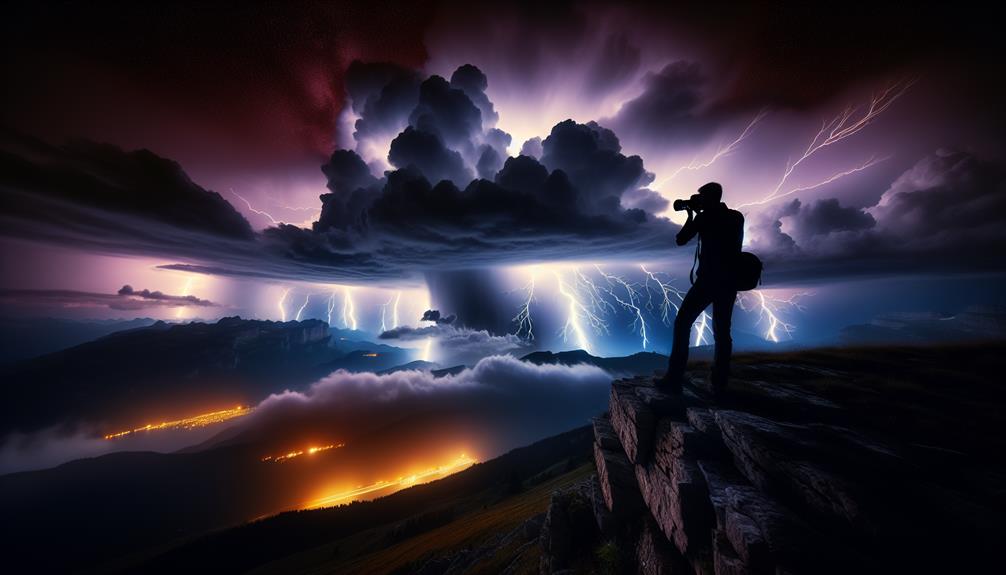When capturing lightning strikes, we start by selecting a remote location with clear views and minimal light pollution, ensuring both safety and stunning foregrounds. We set up our camera on a sturdy tripod, using a low ISO, small aperture, and long exposure to snap electrifying bolts with sharp detail. It's essential to manually focus on a distant object and adjust for ambient light to achieve crisp shots. During storms, staying inside our car acts as a Faraday cage, keeping us safe while shooting. Post-storm, we meticulously review and edit our images for perfection. There's much more behind creating jaw-dropping lightning photos.
Key Points
- Choose remote locations with unobstructed views and minimal light pollution for better lightning capture.
- Use a sturdy tripod and manual focus set to infinity for sharp, long-exposure shots.
- Optimize camera settings with low ISO, small aperture, and long exposure for detailed lightning images.
- Stay inside your car during storms to remain safe while photographing lightning.
Choosing the Right Location
Why does selecting the perfect vantage point make all the difference when capturing lightning strikes? The answer lies in how we blend technical precision with artistic insight.
Weather conditions play an essential role in our planning ahead. We need to understand weather patterns, storm trajectories, and lightning frequency. It's not just about finding any storm; it's about finding the right storm.
Remote locations often provide the best opportunities. They offer unobstructed views and minimal light pollution, enhancing our ability to capture the brilliance of lightning. However, accessing these locations requires a strategic approach. Timing strategies are essential; we must arrive well before the storm hits to set up safely and choose the best spot.
We also need to take into account the landscape. A striking foreground can turn a good lightning photo into a masterpiece. Whether it's a solitary tree, a mountain range, or a wide-open plain, the right landscape complements the dramatic sky.
Setting Up Your Camera
Mastering the art of capturing lightning strikes begins with meticulously setting up your camera for best performance.
First, let's consider our camera angles. Positioning is key to framing those electrifying bolts. We need to scout the horizon and guarantee we've a clear, unobstructed view of the sky. This vantage point not only heightens the drama but also optimizes our chances of capturing those elusive strikes.
Next, tripod stability is non-negotiable. Lightning photography demands long exposures, which means any slight movement can ruin an otherwise perfect shot. A sturdy tripod eliminates this risk, providing the rock-solid foundation our camera needs. Let's make sure to set it up on level ground and anchor it down if necessary to withstand any gusts of wind.
Now, onto focus. We switch to manual focus mode to prevent the camera from hunting in the dark. By pre-focusing on a distant object, we secure the lightning appears sharp and crisp. Proper focus, combined with the right camera angles, enhances the visual impact of each frame.
Lastly, let's be mindful of ambient lighting. We might need to adjust our composition to avoid light pollution, securing the lightning remains the star of our shot.
Optimizing Camera Settings
With our camera properly set up, let's now fine-tune the settings to guarantee we capture lightning strikes with stunning detail and clarity.
First, we need to dial in our exposure settings. Set your camera to manual mode, and choose a low ISO, typically around 100 or 200, to minimize noise. Use a small aperture, like f/8 or f/11, for a deeper depth of field and sharper focus. Shutter speed is vital; start with a long exposure, around 15-30 seconds, to increase the chances of capturing a strike.
Next, let's talk composition techniques. Framing the shot is essential; include interesting elements like distant landscapes or cityscapes to add context and scale. Use the rule of thirds to position the horizon and lightning strike points for a more balanced and dynamic image.
Now, onto focusing tips. Switch to manual focus and set it to infinity to make sure the entire scene is sharp. Double-check the focus in live view, especially under varying lighting conditions.
Staying Safe in Your Car
Securing our safety during a lightning storm means remaining inside the car, which acts as a Faraday cage and protects us from electrical discharges. When we're out storm chasing, the thrill of lightning photography can sometimes make us forget the inherent risks. But our car, with its metal frame, can shield us from lightning strikes, allowing us to focus on capturing that perfect shot without compromising our safety.
To maximize this protection, we should keep the windows rolled up and avoid touching any metal parts inside the car. This guarantees that if lightning strikes, the electrical charge will pass harmlessly through the vehicle's exterior.
While it might be tempting to step out for a better angle, staying put is essential. We can position the camera on a sturdy tripod, set it up in the backseat, and use a remote shutter release to minimize exposure.
Let's embrace the freedom and excitement of lightning photography without disregarding the significance of safety. Our car isn't just a mode of transport; it's a secure base that lets us chase storms and capture nature's spectacular light shows. By respecting these boundaries, we can continue pursuing our passion with both artistry and precision.
Reviewing Your Shots

Once the storm has passed, we can enthusiastically immerse ourselves in reviewing our shots to evaluate our success in capturing lightning's fleeting brilliance. Our first step is to scrutinize each image, identifying those that perfectly showcase the lightning bolt's intricate details against the dramatic sky.
For effective photo critique, let's focus on the composition. Did we capture the lightning within a compelling frame? Are there interesting elements in the foreground or background that enhance the overall scene? Utilizing composition tips, we can assess whether the rule of thirds or leading lines have effectively guided the viewer's eye.
Moving on to post processing, we'll employ precise editing techniques to bring out the best in our images. Adjusting contrast and brightness can reveal hidden details in both the lightning and the surrounding clouds. Enhancing the color saturation might accentuate the electric hues of the sky, while careful noise reduction guarantees clarity without sacrificing detail.
Frequently Asked Questions
What Type of Lens Is Best for Capturing Lightning Strikes?
We recommend using wide-angle lens options for capturing lightning strikes. This allows us to encompass more of the sky. Adjust techniques, settings, and lighting conditions accordingly to guarantee sharp, clear shots that highlight the storm's dramatic beauty.
How Can I Predict When and Where Lightning Will Strike?
We can predict lightning by using lightning detection apps and monitoring weather radar. Lightning safety is essential; always stay updated on storm movements and avoid open areas. This blend of technology and vigilance enhances our chances of capturing strikes.
Are There Any Smartphone Apps That Help With Lightning Photography?
When it comes to capturing lightning, smartphone apps can be our guiding stars. They offer impressive accuracy and effectiveness, enhancing our lightning photography. These apps complement our equipment and techniques, making the experience both technical and artistic.
What Are Some Common Mistakes to Avoid When Photographing Lightning?
We often overlook lighting exposure and composition tips. Avoid overexposing the lightning; use shorter shutter speeds. Don't neglect foreground elements; they enhance the drama. Keep your horizon level for balanced shots. Freedom in creativity, precision in execution.
How Can I Protect My Camera Equipment During a Lightning Storm?
In the blink of an eye, lightning can wreak havoc on our precious gear. For equipment protection, camera covers are essential. Prioritize lightning safety and take personal precautions to guarantee both you and your gear stay safe.


